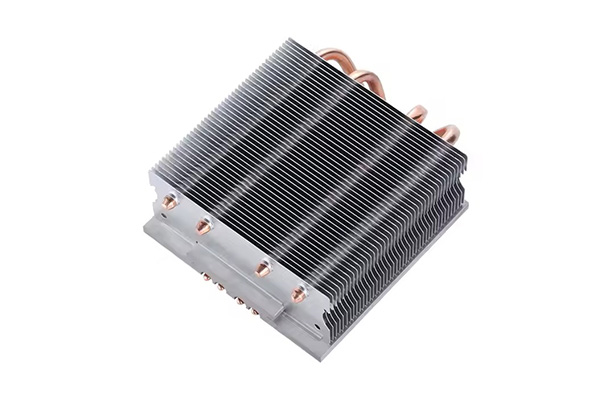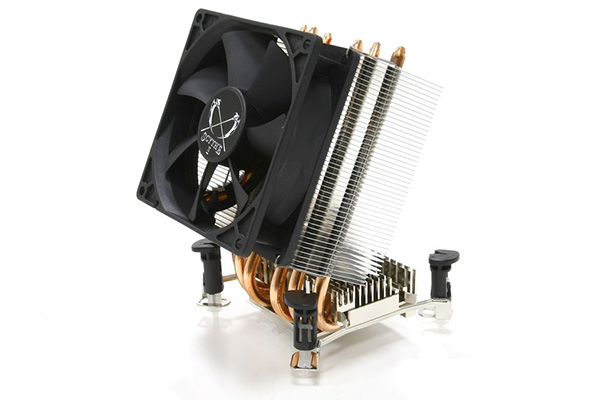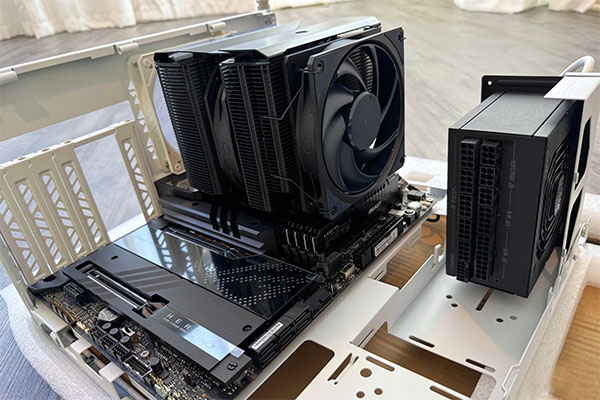Perkenalan
Identifying your CPU cooler model is crucial for ensuring that your computer runs at optimal performance. Whether you need to upgrade your cooler, replace a faulty part, or simply understand what cooling system is currently in use, this article will guide you through the entire process. By the end of this guide, you’ll have the knowledge to identify, maintain, and even upgrade your CPU cooler, ensuring your system remains cool under pressure.

1. What is a CPU Cooler?
A CPU cooler is a device designed to dissipate the heat produced by the central processing unit (CPU) of a computer. CPUs generate a significant amount of heat during operation, and if this heat is not properly managed, it can lead to performance issues or even permanent hardware damage. But here’s the kicker: A cooler not only prevents your system from overheating but also plays a crucial role in your computer’s efficiency and longevity.
There are several types of CPU coolers, primarily air and liquid coolers. Air coolers, which are more common, consist of a heat sink and a fan. The heat sink is made of a material that conducts heat away from the CPU, while the fan blows air over the heat sink to dissipate the heat into the surrounding environment. Liquid coolers, on the other hand, use a pump and a closed-loop system of tubes filled with coolant to absorb the heat and then transfer it away from the CPU.
What’s the real story? The type of cooler you use impacts your system’s cooling efficiency, noise level, and ease of installation. Liquid coolers tend to be more effective at cooling high-performance CPUs, especially when overclocked, but air coolers are generally simpler to install and maintain.
2. Why Do You Need to Know Your CPU Cooler?
Knowing your CPU cooler is essential for several reasons. For one, understanding what cooler you have can help ensure compatibility with your system’s other components, especially when considering upgrades or replacements. Ready for the good part? Your cooler plays a significant role in the overall performance of your CPU, particularly in terms of temperature management and overclocking.
If your CPU cooler is underperforming or outdated, it could lead to higher temperatures, system instability, and a shorter lifespan for your hardware. Monitoring your cooler’s condition allows you to make necessary adjustments or upgrades to avoid these issues.
Moreover, knowing the cooler you have can help you choose the right replacement part when the time comes. Some coolers are built to last a lifetime, while others may require periodic maintenance or even full replacement. This is where understanding the model and type of cooler you have will save you time and effort when searching for compatible upgrades.
3. How to Check What CPU Cooler You Have
Now that we know the importance of identifying your cooler, let’s dive into how to actually do it. First, the most straightforward method is to manually inspect your cooler. If your PC has a transparent case or if you can easily access the internal components, you can simply look at the cooler to check its brand and model. What’s the catch? Some coolers may have their branding or model number on a sticker or etched into the metal, while others may be more difficult to identify without detailed information.
If you can’t physically see your cooler, don’t worry—there are other ways to find this information. One of the easiest methods is by checking your system’s BIOS or UEFI firmware. These system-level tools often display detailed information about your hardware, including the cooler. This is where it gets interesting: If your cooler has sensors integrated, the BIOS may even show the current temperatures, which can help you assess its efficiency.
Lastly, if you’re still stumped, you can use software tools like CPU-Z or HWiNFO to gather detailed information about your system’s components. These programs provide insight into everything from your CPU’s temperature to the type of cooler you’re using.
4. Where Can You Find Your CPU Cooler’s Model Information?
Finding the exact model of your CPU cooler can sometimes be tricky, but there are several places to look. The first place you should check is the cooler itself. Most coolers have labels or stickers that display the manufacturer’s name and the model number. These labels are usually located on the side or top of the cooler, depending on the design. But here’s the kicker: Some coolers, especially custom-built ones, might not have this information clearly marked.
In this case, the next best option is to check your system’s documentation. If you purchased a pre-built PC, the manufacturer’s website or the system’s user manual might have specific information about the installed cooler. For custom-built systems, you can often find the cooler model in the receipt or documentation from when the system was assembled.
Another option is to use software tools like CPU-Z or HWMonitor. These programs may not provide detailed information about the cooler itself but can give you a broader understanding of your system’s thermal performance, helping you make an educated guess about what cooler you’re using based on its efficiency and cooling capacity.
5. How Do I Identify the Brand of My CPU Cooler?
Identifying the brand of your CPU cooler is relatively straightforward if you know where to look. The first step is to check for any branding or logos directly on the cooler. Many manufacturers place their logo prominently on the fan or the heat sink. But wait, there’s more! If you don’t spot any logos, you can look for part numbers or model names that could point you to the manufacturer.
If you still can’t figure it out, don’t worry—there are software tools that can help. Programs like CPU-Z or HWiNFO often provide detailed information about the components in your system. While these tools may not always display the exact brand, they can sometimes point to the cooler’s type or even its specifications, which can lead you to the brand.
In cases where the brand is still elusive, an online search of the part numbers you find on your cooler can often reveal the manufacturer’s name and the cooler’s model. It’s worth noting that many well-known brands, like Noctua, Cooler Master, and Corsair, have distinctive designs that can help you identify them visually.

6. What if I Can’t Find My CPU Cooler Model?
If you’re unable to locate the model information of your cooler, there are still options available to you. First, try reaching out to the original manufacturer or retailer. They may have records of the product they sold you and could help you identify the cooler model. But here’s the kicker: If your cooler was custom-built or you’ve lost the original documentation, things get trickier.
The next best option is to check the performance of your cooler. If your cooler is not performing as expected, you might want to monitor the temperatures and consider replacing it. Using monitoring software to track the CPU temperature will give you a sense of whether the cooler is working as it should.
For custom systems, it’s possible that a less-known brand or a generic cooler was used, which might not have easily identifiable markings. In this case, finding a compatible replacement can be a challenge, but identifying the socket type and thermal requirements of your CPU can help narrow down your options.
7. Can I Upgrade My CPU Cooler?
Upgrading your CPU cooler can be a great way to improve your system’s cooling performance, particularly if you’re planning to overclock your CPU or if your current cooler isn’t doing a good job of maintaining lower temperatures. So, how do you know if it’s time for an upgrade?
The first factor to consider is compatibility. Not all coolers fit all CPU sockets, so you’ll need to verify that your cooler is compatible with your motherboard. The good news is that most manufacturers provide detailed compatibility charts to help you choose the right cooler for your system.
Another key consideration is cooling capacity. If your current cooler struggles to keep your CPU at optimal temperatures, upgrading to a more powerful cooler could improve both performance and longevity. And here’s the thing: upgrading to a more efficient cooler can also reduce noise levels, as some high-performance coolers operate more quietly than standard models.
If you’re building a high-performance machine or planning to push your system to its limits with tasks like video editing or gaming, a liquid cooler may be a better option due to its superior cooling capacity. However, if you’re on a budget or prefer simplicity, a high-end air cooler can also do the job effectively.
8. What Are the Key Differences Between Air and Liquid Coolers?
When it comes to cooling your CPU, the two primary options are air coolers and liquid coolers. But here’s the kicker: Both types have their pros and cons, and the right choice depends on your specific needs and preferences.
Air coolers are simpler and more cost-effective. They work by using a heat sink to absorb heat from the CPU and a fan to blow the hot air away. While they are effective at cooling standard CPUs, they tend to be larger and noisier than liquid coolers. The advantage of air coolers is their ease of installation, lower cost, and reliability over time.
Liquid coolers, on the other hand, are more complex but offer superior cooling performance, particularly in high-performance setups. They use a closed-loop system that circulates coolant through a series of tubes to absorb heat from the CPU and transfer it to a radiator, where the heat is dissipated. Liquid coolers are generally quieter and more effective at cooling overclocked CPUs, making them ideal for high-performance systems or gaming rigs. However, they come at a higher price point and require more careful installation and maintenance.
The bottom line is that if you’re building a high-performance PC or planning on overclocking, a liquid cooler might be the better option. For general use, however, an air cooler is typically more than sufficient.
9. How Does a CPU Cooler Impact Your Computer’s Performance?
A CPU cooler’s primary role is to maintain optimal temperatures for your CPU, preventing it from overheating during heavy usage. But what’s the real story? A cooler’s effectiveness can directly influence your system’s performance, particularly in tasks that put your CPU under heavy load, such as gaming, video editing, or running resource-intensive applications.
Overheating can cause your CPU to throttle its speed, meaning it will slow down to avoid damaging itself. This can result in noticeable performance drops and system instability. Additionally, prolonged exposure to high temperatures can lead to thermal damage and reduce the lifespan of your CPU and other components.
By ensuring that your CPU remains cool under pressure, a quality cooler helps maintain consistent performance levels, even during intense workloads. Liquid coolers, in particular, excel in this area, offering superior thermal dissipation that allows your CPU to run at peak performance without throttling.
10. What Should You Look for When Choosing a CPU Cooler?
Choosing the right CPU cooler involves several key factors. First, you’ll need to check compatibility. Coolers come in various sizes, and not all will fit every CPU socket or case size. Most coolers will list the compatible CPU sockets and case dimensions, so you can easily find one that fits your needs.
The second factor to consider is cooling performance. If you plan to overclock your CPU or use your PC for heavy tasks like gaming or video editing, you’ll need a cooler that can handle high heat loads. Liquid coolers generally provide superior cooling performance, but high-end air coolers can also be effective.
Another important factor is noise. While some coolers are designed to operate quietly, others can be quite loud, especially under load. If noise is a concern, look for coolers specifically designed for low noise levels.
Lastly, consider the price. CPU coolers come in a wide price range, and while higher-end coolers typically offer better performance, they may not always be necessary for all users. It’s important to balance your needs and budget when choosing the right cooler for your system.

11. How to Install a New CPU Cooler?
Installing a new CPU cooler might seem like a daunting task, but with the right steps, it’s relatively straightforward. Ready for the good part? The installation process typically involves removing the old cooler, cleaning the CPU, applying thermal paste, and then mounting the new cooler.
Here’s a basic overview of the process:
- Remove the old cooler: Begin by turning off your PC, unplugging it, and removing the side panel. Disconnect the old cooler and carefully remove it from the CPU socket.
- Clean the CPU: Use a lint-free cloth and some isopropyl alcohol to clean off the old thermal paste from the CPU.
- Apply new thermal paste: Squeeze a small, pea-sized amount of thermal paste onto the center of the CPU.
- Install the new cooler: Carefully place the cooler onto the CPU socket and secure it according to the manufacturer’s instructions.
- Reconnect the cooler’s fan: Make sure the fan is properly connected to the motherboard and running.
By following these steps, you can ensure that your new cooler is installed correctly and efficiently.
12. How Can You Maintain Your CPU Cooler?
Proper maintenance of your CPU cooler is essential for its longevity and performance. Over time, dust and dirt can accumulate on the fan and heat sink, reducing the cooler’s efficiency. Regularly cleaning your cooler can prevent this buildup and ensure optimal airflow.
To clean your cooler, first, power down your system and unplug it from the wall. Use compressed air or a soft brush to remove dust from the fan blades, heat sink, and other components. Be sure to do this gently to avoid damaging the cooler.
In addition to cleaning, it’s important to monitor your system’s temperatures regularly. If you notice that your CPU temperatures are higher than usual, it might be time to clean the cooler or apply new thermal paste. You can also use software tools to track temperature readings and ensure your cooler is functioning properly.
13. Can a Bad CPU Cooler Cause Computer Issues?
Yes, a malfunctioning or inefficient CPU cooler can cause serious problems for your computer. Overheating can lead to system instability, random shutdowns, and a decrease in overall performance. In severe cases, overheating can cause permanent damage to your CPU or motherboard.
Signs that your CPU cooler may be malfunctioning include excessively high CPU temperatures, frequent system crashes, or noticeable fan noise. If your cooler is not functioning properly, it’s essential to replace or repair it as soon as possible to avoid damaging other components in your system.
14. How Much Does a Good CPU Cooler Cost?
The cost of a CPU cooler varies significantly depending on the type and brand. Budget air coolers can cost as little as $20–$40, while high-end models can range from $50–$100 or more. Liquid coolers tend to be more expensive, with prices ranging from $60 to $200, depending on the brand and cooling performance.
Keep in mind that while it’s tempting to go for the cheapest option, investing in a higher-quality cooler can result in better performance, quieter operation, and a longer lifespan for your system. If you’re building a high-performance PC, it’s worth spending a little extra on a quality cooler that can handle demanding tasks.
15. When Should You Replace Your CPU Cooler?
Replacing your CPU cooler is something that most users don’t think about until something goes wrong. However, there are a few signs that indicate it might be time for a replacement. If your cooler is constantly running loud or if you notice elevated CPU temperatures, it may be time to upgrade. Additionally, if your cooler is old and doesn’t meet the demands of newer, high-performance CPUs, a replacement could be a wise investment.
When replacing your cooler, it’s important to choose one that is compatible with your system and provides the level of cooling required for your tasks.
Kesimpulan
In this article, we’ve covered everything you need to know about identifying, maintaining, and upgrading your CPU cooler. From understanding what a CPU cooler is to recognizing when it’s time for a replacement, knowing your cooler is essential for maintaining your system’s performance and stability. Keep your cooler in good condition, monitor your system’s temperatures, and don’t hesitate to upgrade when needed. Your computer’s longevity and performance depend on it.

Tanya Jawab Umum
Pertanyaan 1: Apa itu pendingin CPU?
A CPU cooler is a device used to dissipate the heat produced by the central processing unit (CPU) to keep it at optimal operating temperatures.
Pertanyaan 2: How does a CPU cooler work?
A CPU cooler works by transferring heat away from the CPU using either air or liquid, through heat sinks, fans, and sometimes thermal compounds, to maintain a safe operating temperature.
Pertanyaan 3: What are the differences between air and liquid CPU coolers?
Air coolers use a heat sink and fan to dissipate heat, while liquid coolers use a closed-loop liquid system to transfer heat away from the CPU, often providing more efficient cooling, especially for high-performance systems.
Pertanyaan 4: How can I tell if my CPU cooler is working properly?
Signs of a malfunctioning CPU cooler include higher-than-usual CPU temperatures, system crashes, excessive fan noise, or a failure to detect the cooler in system software.
Pertanyaan 5: How often should I replace my CPU cooler?
Typically, a CPU cooler can last for several years, but it should be replaced if you notice issues with cooling performance, noise, or if it’s significantly outdated for newer hardware.

